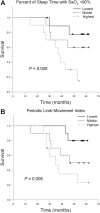Nocturnal hypoxemia and periodic limb movement predict mortality in patients on maintenance hemodialysis
- PMID: 20507958
- PMCID: PMC2974401
- DOI: 10.2215/CJN.08881209
Nocturnal hypoxemia and periodic limb movement predict mortality in patients on maintenance hemodialysis
Abstract
Background and objectives: Sleep disorders, including sleep-disordered breathing and periodic limb movements during sleep, are associated with an increased risk for cardiovascular diseases, which are the leading causes of death in patients with ESRD. This study investigated the association between sleep disorders and mortality in patients with ESRD.
Design, setting, participants, & measurements: Thirty patients on maintenance hemodialysis, who were clinically stable for >2 months, underwent overnight polysomnography to evaluate sleep parameters.
Results: All patients were followed for a median of 48 months (range: 14 to 62 months), and 14 of them died during the follow-up period. Among the sleep parameters, the percent of sleep time with arterial oxygen saturation <90% (T <90%), mean arterial oxygen saturation, and periodic limb movement index score were associated with significant increases in the risk of death. However, associations of the apnea-hypopnea index or oxygen desaturation index with mortality were NS. The hazard ratios (95% confidence intervals) for death per one SD increment in the log-transformed T <90% and periodic limb movement index score were 2.10 (1.06 to 4.15) and 2.48 (1.11 to 5.52), respectively, after adjusting for age.
Conclusions: We found that nocturnal hypoxemia and periodic limb movement during sleep, rather than apnea itself, were associated with an increased risk for death in patients with ESRD. However, conclusions from this study should be drawn with caution, because they are limited by the small sample size.
Figures

Similar articles
-
Association of Sleep Apnea with Mortality in Patients with Advanced Kidney Disease.Clin J Am Soc Nephrol. 2020 Feb 7;15(2):182-190. doi: 10.2215/CJN.07880719. Epub 2020 Jan 22. Clin J Am Soc Nephrol. 2020. PMID: 31969341 Free PMC article.
-
Potential novel predictors of mortality in end-stage renal disease patients with sleep disorders.Am J Kidney Dis. 2000 Jun;35(6):1052-60. doi: 10.1016/s0272-6386(00)70039-4. Am J Kidney Dis. 2000. PMID: 10845816
-
Nocturnal Hypoxemia, But Not Sleep Apnea, Is Associated With a Poor Prognosis in Patients With Pulmonary Arterial Hypertension.Circ J. 2018 Nov 24;82(12):3076-3081. doi: 10.1253/circj.CJ-18-0636. Epub 2018 Oct 16. Circ J. 2018. PMID: 30333436
-
Sleep disorders in end-stage renal disease: 'Markers of inadequate dialysis'?Kidney Int. 2006 Nov;70(10):1687-93. doi: 10.1038/sj.ki.5001791. Epub 2006 Sep 13. Kidney Int. 2006. PMID: 16969388 Review.
-
Sleep apnea and daytime sleepiness in end-stage renal disease.Semin Dial. 2004 Mar-Apr;17(2):109-14. doi: 10.1111/j.0894-0959.2004.17206.x. Semin Dial. 2004. PMID: 15043611 Review.
Cited by
-
Sleep apnoea syndrome prevalence in chronic kidney disease and end-stage kidney disease patients: a systematic review and meta-analysis.Clin Kidney J. 2023 Nov 14;17(1):sfad179. doi: 10.1093/ckj/sfad179. eCollection 2024 Jan. Clin Kidney J. 2023. PMID: 38186876 Free PMC article.
-
Obstructive Sleep Apnea Increases Sudden Cardiac Death in Incident Hemodialysis Patients.Am J Nephrol. 2018;48(2):147-156. doi: 10.1159/000489963. Epub 2018 Aug 15. Am J Nephrol. 2018. PMID: 30110675 Free PMC article.
-
The Clinical Importance of Periodic Leg Movements in Sleep.Curr Treat Options Neurol. 2017 Mar;19(3):10. doi: 10.1007/s11940-017-0446-5. Curr Treat Options Neurol. 2017. PMID: 28349352 Review.
-
Impact of Desaturation Patterns versus Apnea-Hypopnea Index in the Development of Cardiovascular Comorbidities in Obstructive Sleep Apnea Patients.Nat Sci Sleep. 2022 Aug 25;14:1457-1468. doi: 10.2147/NSS.S374572. eCollection 2022. Nat Sci Sleep. 2022. PMID: 36045914 Free PMC article. Review.
-
The efficacy and tolerability of rotigotine on patients with periodic limb movement in sleep: A systematic review and meta-analysis.PLoS One. 2018 Apr 18;13(4):e0195473. doi: 10.1371/journal.pone.0195473. eCollection 2018. PLoS One. 2018. PMID: 29668694 Free PMC article.
References
-
- Jurado-Gamez B, Martin-Malo A, Alvarez-Lara MA, Munoz L, Cosano A, Aljama P: Sleep disorders are underdiagnosed in patients on maintenance hemodialysis. Nephron Clin Pract 105: c35–42, 2007 - PubMed
-
- Markou N, Kanakaki M, Myrianthefs P, Hadjiyanakos D, Vlassopoulos D, Damianos A, Siamopoulos K, Vasiliou M, Konstantopoulos S: Sleep-disordered breathing in nondialyzed patients with chronic renal failure. Lung 184: 43–49, 2006 - PubMed
-
- Jung HH, Han H, Lee JH: Sleep apnea, coronary artery disease, and antioxidant status in hemodialysis patients. Am J Kidney Dis 45: 875–882, 2005 - PubMed
-
- Rijsman RM, de Weerd AW, Stam CJ, Kerkhof GA, Rosman JB: Periodic limb movement disorder and restless legs syndrome in dialysis patients. Nephrology (Carlton) 9: 353–361, 2004 - PubMed
-
- Hohl-Radke F, Aedtner F, Domrose U, Neumann KH, Staedt J: [Restless legs syndrome in patients on dialysis for kidney insufficiency: Effect of medication]. Dtsch Med Wochenschr 133: 71–75, 2008 - PubMed
MeSH terms
Substances
LinkOut - more resources
Full Text Sources
Medical
Miscellaneous

